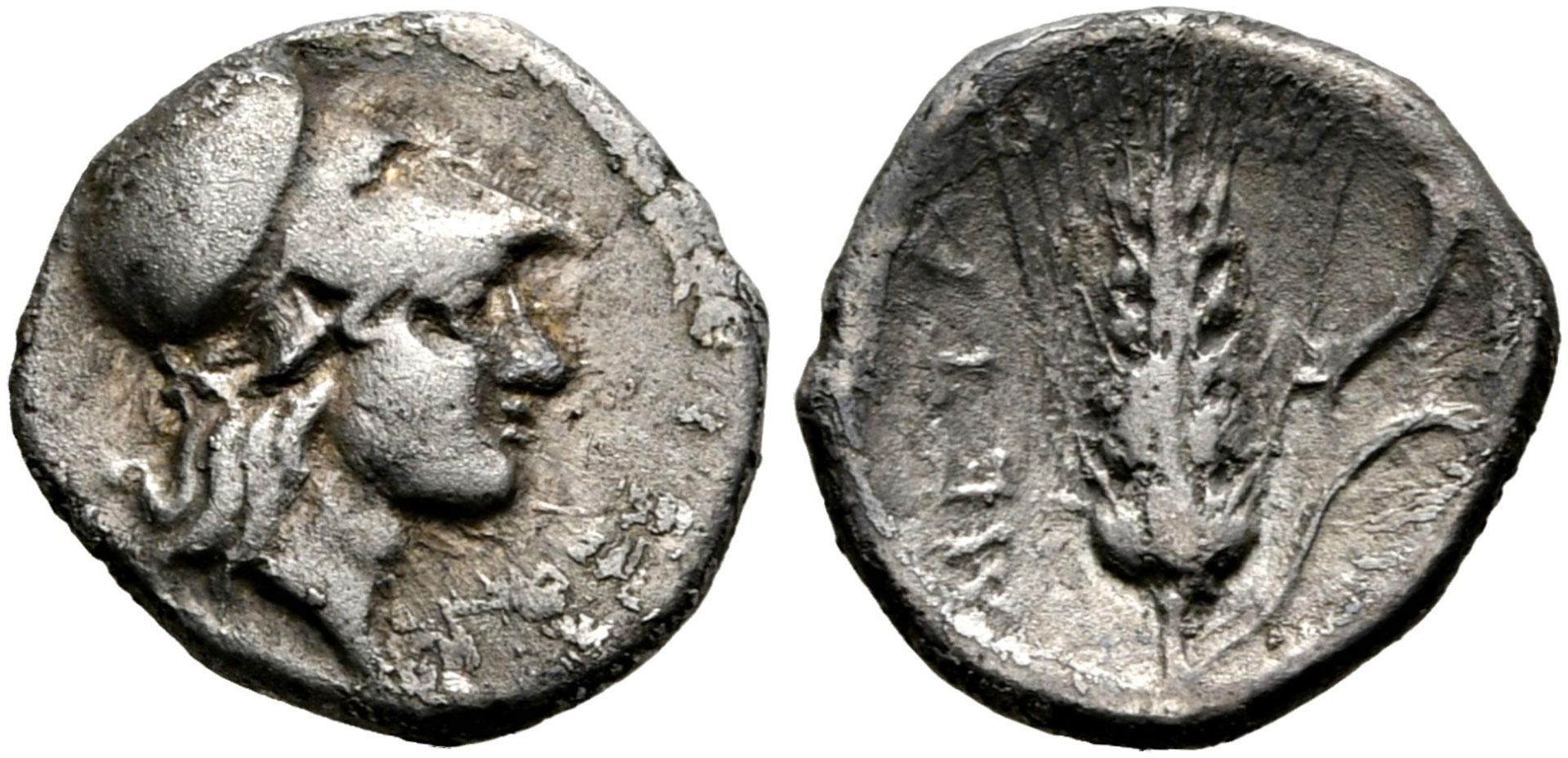Metapontum, silver, diobols (285-275 BCE)
From SILVER
285 BCE - 275 BCE Silver 1,950 kg
Description
| ObverseInscription or printing placed on the obverse.: | Several types, heads left or right: 1) Demeter right, 2) Apollo Carneios left, 3) Athena right, 4) Zeus Ammon right. |
| ReverseInscription or printing placed on the reverse.: | META (Greek).Ear of barley, with plough on leaf |
Mint and issuing power
| MintIdentifies the place of manufacture or issue of a numismatic object.: | Metapontum | Ancient regionAncient region.: | Lucania | Modern countryModern country: Italy | AuthorityIdentifies the issuing power. The authority can be "pretended" when the name or the portrait of X is on the coin but he/she was not the issuing power. It can also be "uncertain" when there is no mention of X on the coin but he/she was the issuing power according to the historical sources: |
Chronology
| FromIdentifies the initial date in a range assigned in a numismatic context. | 285 BCE | toIdentifies the final date in a range assigned in a numismatic context.. | 275 BCE | PeriodTime period of the numismatic object.: Hellenistic 323-30 BC |
Physical description
| MetalThe physical material (usually metal) from which an object is made.: | Silver |
Median weightMedian of the weights of numismatic objects (in grams). in grams | 1.05 | DenominationTerm indicating the value of a numismatic object. Examples: tetradrachm, chalkous, denarius.: | diobol |
StandardStandard.: |
Image

RQEMH 6 - Metapontum, silver, diobol, 285-275 BC.jpg [1]
References
| Die study referencePublication of the study: | Johnston 19901Johnston 1990 | ||
| Coin series referenceReference to coin series study: | Sear I2Sear I, n° 419-422, RQEMH3RQEMH, n° 6, HN Italy4HN Italy, n° 1595-1599, HGC 15HGC 1, n° 1077-1079 | ||
| Coin series web referenceCoin series web references: | |||
Obverse dies distribution
| FrequencyFrequency of specimen in distribution. ᵖ | Number of obversesNumber of obverse dies. ᵖ (o) | % (o) | Number of coinsNumber of coins. (n) | % (n) | Die nameName(s) of the die(s). |
| 1 | 26 | 78.79 | 26 | 56.52 | 2.11;3.1;4.1;5.1;6.2;6.3;6.4;7.1;7.2;8.1;12.1;12.2;13.3;14.1;14.2;15.1;17.1;18.1;18.2;18.3;19.1;20.1;22.1;22.2;23.1;24.1 |
| 2 | 4 | 12.12 | 8 | 17.39 | 2.1;5.2;12.3;12.4 |
| 4 | 3 | 9.09 | 12 | 26.09 | 2.3;2.7;2.9 |
| Total | 33 of 33 | 100 | 46 of 46 | 100 |
Reverse dies distribution
no distribution is available
Quantification
| Number of obversesNumber of obverse dies. ᵖ (o) | 33 | Number of singletons (o1)The number of singleton coins. ᵖ | 26 |
| Number of reverse diesNumber of reverse dies. (r) | 38 | Number of coinsNumber of coins. (n) | 46 |
| Coins per obverse dieNumber of coins per obverse die. (n/o) | 1.39 | Coins per reverse dieNumber of coins per reverse die. (n/r) | 1.21 |
| Reverse per obverse ratioRatio of obverse dies divided by reverse dies. (r/o) | 1.15 | Percentage of singletons (o1)number of coins (n) divided by the number of singletons (o1) ᵖ | 78.79 % |
| Original number of dies (O) (Carter 1983 formula)The estimation of the number of coins according to Carter 1983 ᵖ | 92.88 | Coins struck if 20,000 as average productivity per dieCoins made if the average productivity for obverses (according to Carter) is 20,000. ᵖ | 1,857,600 |
| Original number of dies (O) (Esty 2011 formula)The estimation of the number of coins according to the singleton formula in Esty 2011 ᵖ (O) | 116.77 | Survival rate if 20,000 as average productivity per dieSurvival rate if average productivity is 20,000. ᵖ | 0.00002 |
| Coverage (o = % of O) (Esty 1984 formula)Esty 1984 - coverage (% of O) ᵖ (o = % of O) | 43.48% | Die productivity if survival rate 1/2,000Average productivity if survival rate is 1/2,000. ᵖ | 990.53 |
| Weight of silver (in kg) if 20,000 coins per die (O = Carter formula)Carter 1983 * Median weight * 20000 (*10 if gold or electrum) ᵖ | 1,950 kg <br /> 1,950 kg | Die productivity if survival rate 1/5,000Average productivity if survival rate is 1/5,000. ᵖ | 2,476.31 |
Remarks
References
- ^ Johnston, Ann (1990), The Coinage of Metapontum. Part 3, Numismatic Notes and Monographs, 164, New York.
- ^ Sear, David R. (1978), Greek coins and their values. Vol. I, Europe, London, xl, 316 p.
- ^ Callataÿ, François de (1997), Recueil quantitatif des émissions monétaires hellénistiques, Numismatique Romaine, Wetteren, X + 341 p.
- ^ Rutter N. Keith et alii (eds.) (2001), Historia Numorum Italy, London, xvi, 223 p., 43 pl.
- ^ Hoover, Oliver D. (2018), The Handbook of Greek Coinage Series, Volume 1. Handbook of Coins of Italy and Magna Graecia, Sixth to First Centuries BC., Lancaster-London, 2018, lxi, 527 pages, 23 cm